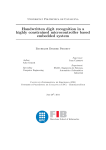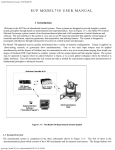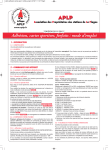Download Histogram DB for Online Monitoring – User`s Manual
Transcript
Histogram DB for Online
Monitoring – User’s Manual
Issue:
Revision:
2
0
Reference:
Created:
Last modified:
March 21, 2007
March 21, 2007
Prepared by:
G. Graziani
Histogram DB for Online Monitoring – User’s Manual
1 DB design
1
Ref:
Issue: 2
Date: March 21, 2007
DB design
The requirements and use cases of an Histogram Database for Online Monitoring in the context of a
common Histogramming Framework [1] have been defined in [2].
The present design of DB tables is shown in figure 1
Figure 1 Scheme of DB tables.
1.1
Definition of Histograms
Histograms are uniquely identified by the expression:
Taskname/Algorithmname/HistogramName
The histogram name can contain a subname: HistogramName = HistogramSetName $$ Subname
Histograms differing only by Subname are part of the same Histogram set. These should be histograms
that have identical binning, e.g. containing the same distribution for different channels of a detector.
For easier reference, an internal unique identifier is created for each histogram, in the form
HID = HSID/IHS
where HSID is an integer number identifying the histogram set, and IHS is a sequence number (starting from 1) to identify histograms in the same set.
1.1.1 Properties of TASK
— TaskName (string of max length 100)
unique task identifier
— RunOnPhysics, RunOnCalib, RunOnEmpty (boolean)
specify for which type of data task is running
— Subsys1, Subsys2, Subsys3 (string of length 10)
up to 3 subdetector/subsystem can be associated to task.
— Reference (string of length 100)
link to the location of reference histograms for this task
page 1
Histogram DB for Online Monitoring – User’s Manual
1 DB design
Ref:
Issue: 2
Date: March 21, 2007
1.1.2 Properties of HISTOGRAMSET
— HSID (integer)
— NHS (integer)
number of histograms in set
— Task (valid TaskName)
— Algorithm (string of max length 100)
— HistogramSetName (string of max length 200)
— Type
’H1D’, ’H2D’ for normal histograms, ’P1D’, ’P2D’ for profile histograms, ’CNT’ for counters
— Nanalysis (integer)
number of analysis to be performed on set
— Description (string of max length 4000)
— Documentation (string of max length 200)
link to a more extensive documentation
— HSDisplay (valid DOID)
identifier of display option set associated to Histogram set
1.1.3 Properties of HISTOGRAM
— HID (string of max length 12)
HSID/IHS
— Subname (string of max length 50)
— DIMServiceName (string of max length 130)
Name of the DIM service that is currently publishing the histogram
— IsAnalysisHist (boolean)
true if histogram is produced at analysis level
— CreationTime (timestamp)
recording the first time the histogram is seen
— ObsoletenessTime (timestamp)
can be set by hand if histogram is not produced any more
— Display (valid DOID) identifier of display option set associated to Histogram
1.2
Definition of Pages and Display Options
Pages and Page Folders are uniquely identified by their name. Page folders can have a hierarchical
structure, for example:
Folder1
Folder1/Folder2
Folder1/Folder2/Folder3
Pages are associated to a list of valid histograms through the SHOWHISTO table, containing the layout of each histogram on the page.
As shown in figure 1, a set of display options can be defined for:
an histogram on a given page
page 2
Histogram DB for Online Monitoring – User’s Manual
1 DB design
Ref:
Issue: 2
Date: March 21, 2007
an histogram
an histogram set
so that the most specific available set is used, but one can use the same default for, say, the 2000
histograms of a certain set.
1.2.1 Properties of DISPLAYOPTIONS
— DOID (integer)
unique identifier
— LABEL X (string of max length 50)
— LABEL Y (string of max length 50)
— LABEL Z (string of max length 50)
— YMIN (float)
— YMAX (float)
— STATS (int)
— FILLSTYLE (int)
— FILLCOLOR (int)
— LINESTYLE (int)
— LINECOLOR (int)
— LINEWIDTH (int)
— DRAWOPTS (string of max length 50)
1.2.2 Properties of PAGEFOLDER
— PageFolderName (string of max length 30)
unique page folder identifier
— Parent (string of max length 30)
Folder containing this folder (NULL for “root” folders)
1.2.3 Properties of PAGE
— PageName (string of max length 50)
unique page identifier
— Folder (valid PageFolderName)
— Nhisto (integer)
number of histograms on page
— PageDoc (string of max length 100)
short page description
page 3
Histogram DB for Online Monitoring – User’s Manual
1 DB design
Ref:
Issue: 2
Date: March 21, 2007
1.2.4 Properties of SHOWHISTO
The unique identifier is the combination (Page,Histo,Instance)
— Page (valid PageName)
— Histo (valid HID)
— Instance (int)
sequence number (starting from 1) to distinguish different instances of the same histogram on
the same page
— Cx, Cy, Sx, Sy (float numbers from 0 to 1)
coordinates of the histogram pad on the page: Cx and Cy define the position of the top left
corner, Sx and Sy the size, relatively to the window size
— Sdisplay (valid DOID)
identifier of display option set associated to this Histogram on this Page
1.3
Definition of Automatic Analysis
The ALGORITHM table contains the definition of the algorithms available for analysis. They can
be used to create new histograms at analysis level (these will be called “Analysis Histograms” and
are defined by the HCREATOR table), or to perform automatic checks, defined in the ANALYSIS
table. Analyses are properties of an histogram set, though their parameters can be specified for each
histogram in the ANASETTINGS table.
1.3.1 Properties of ALGORITHM
— AlgorithmName (string of max length 30)
unique algorithm identifier
— AlgType
’HCREATOR’ or ’CHECK’
— Ninput (integer)
number of input histograms (for ’HCREATOR’ algorithms)
— Npars (integer)
number of parameters
— AlgPars (array(any length) of string of max length 15)
parameter names
— HCTYPE
for ’HCREATOR’ algorithms, type of histogram generated by this algorithm
— AlgDoc (string of max length 1000) documentation
1.3.2 Properties of ANALYSIS
— AID (integer)
unique analysis identifier (allowing to assign the same algorithm more than once to the same
histogram)
— HSET (valid HSID)
— Algorithm (valid AlgorithmName)
page 4
Histogram DB for Online Monitoring – User’s Manual
4 C++ Interface
Ref:
Issue: 2
Date: March 21, 2007
1.3.3 Properties of ANASETTINGS
— AnaID (valid AID)
— Histogram (valid HID)
— Mask (boolean)
allow to mask the analysis for a single histogram
— Warnings, Alarms (arrays(Npars) of floats)
2 sets of threshold levels
1.3.4 Properties of HCREATOR
when a HCREATOR entry is defined, the corresponding histogram is created with Task=’ANALYSIS’
and Algorithm= the name of the analysis algorithm
— HCID (valid HID)
— Algorithm (valid AlgorithmName)
— Sourceh (arrays(8) of string of max length 12)
list of input histograms
— SourceHSet (valid HSID)
input histogram set (if required by the algorithm)
— HCPARS (arrays(Npars) of floats)
set of needed parameters
2
DB implementation
A first prototype of the DB has been implemented under Oracle on the CERN Oracle server and is
available for tests.
The DB can be accessed through a C++ API or interactively through a Web interface written in PHP.
In order to minimize client load and network traffic, and ease the maintenance of interface code,
both interfaces are based on a set of common PL/SQL procedures that are precompiled on the Oracle
server.
3
Web interface
It is available for test at the address
https://webafs3.cern.ch/ggrazian/lhcb/OnlineHistDB/index.php
It is intended to be the most suitable tool to browse available histograms, edit the display options and
the automatic analysis, including the definition of histograms to be produced at analysis level.
Presently, it is also possible to edit the viewer page configurations, though a graphical editor in the
presenter application will likely be the most suitable tool for that task.
4
C++ Interface
The interface is available as a link library that can be compiled from the package
Online/OnlineHistDB
in the LHCb code repository.
The C++ API allows to perform practically any operation on the DB .
You can add entries to the DB through the methods beginning with declare, that create the specified
entry if not existing, or update its fields otherwise. Thus, running the same code twice is equivalent
to run it once.
page 5
Histogram DB for Online Monitoring – User’s Manual
Ref:
Issue: 2
Date: March 21, 2007
4 C++ Interface
4.1
OnlineHistDB class
Each instantiation of this class opens a transaction with the DB server. Its methods allow the creation
of histograms and pages, and the definitions of tasks, subsystems and algorithms. Histograms and
pages can be edited through the pointers to OnlineHistogram and OnlineHistPage objects returned
by the getHistogram and getPage methods. Such objects make sense only within the transaction and
should never be deleted by the user (they are destroyed by the OnlineHistDB destructor).
Changes are committed to the DB only by an explicit call to the commit method.
By default, DB errors don’t throw exceptions to the client code but for severe inconsistencies (i.e.
bugs). The default behaviour can be changed (see section 4.4). Normally, one can detect errors by the
method return values and choose if commit or not. Histogram declarations are a special case since, in
order to improve performance, they are stored in a buffer, with default depth 1000, and actually sent to
the DB server only when the buffer is full or at commit time. In order to check for errors in histogram
declarations, one can use the sendHistBuffer method to force buffer sending, and check its return value
before committing. Note that if an error occurs and you commit anyway, only all histograms declared
before the error are sent to the DB, and the buffer is emptied.
HistDB(std::string passwd, std::string user=OnlineHistDBEnv constants::ACCOUNT, std::string
db=OnlineHistDBEnv constants::DB);
constructor
bool commit();
commits all changes to the DB. Returns true if there are no errors.
bool declareTask(std::string Name, std::string SubDet1=”NULL”, std::string SubDet2=”NULL”,
std::string SubDet3=”NULL”, bool RunsOnPhysics=false, bool RunsOnCalib=false,
bool RunsOnEmpty=false);
creates or updates a Task definition, returning true on success. Tasks can be associated to up to
three subdetectors/subsystems.
bool declareSubSystem(std::string SubSys);
declares a subsystem, returning true on success
void declareHistByServiceName(const std::string &ServiceName);
declares an Histogram by its DIM service name. In the LHCb DAQ, this is intended to be used
only by the Experiment Control System to dynamically update the DB with the published histograms.
Tasks not known to the DB are automatically created.
If histogram already exists, just updates the current DIM service name
void declareHistogram(std::string TaskName, std::string AlgorithmName, std::string HistogramName, HistType Type);
declares an Histogram by its identifying attributes (no need to know the DIM service name).
The enum HistType is defined in section 4.4.
void setHistogramBufferDepth(int N);
when creating histograms with the declareHistByServiceName method, the histogram list is actually send to the DB server every N histograms (or at commit) in order to optimize performance.
The default buffer depth (recommended value) is 1000.
bool sendHistBuffer();
forces sending histogram declaration buffer to the DB. Returns true if there are no errors.
OnlineHistogram* declareAnalysisHistogram( std::string Algorithm, std::string Name, std::vector
OnlineHistogram* &Sources, std::vector float * Parameters = NULL);
page 6
Histogram DB for Online Monitoring – User’s Manual
Ref:
Issue: 2
Date: March 21, 2007
4 C++ Interface
declares an histogram to be produced at analysis level using algorithm Algorithm. Name is the
histogram name. Sources must contain the pointers to the input histograms. Parameters is a
pointer to a parameter vector, optionally needed by the algorithm. If the algorithm requires an
histogram set as input, use any histogram of the set. Returns the pointer to the new histogram
object.
bool removeHistogram(OnlineHistogram* h, bool RemoveWholeSet = false);
removes an histogram, and optionally its full set. bf This is a temporary method to be used if
needed at the development stage. Will be removed at production stage
bool declareCheckAlgorithm(std::string Name, int Npars, std::string* pars=NULL, std::string
doc=”NONE”);
declares to the DB an Analysis algorithm implemented in the Analysis library. Npars is the number of algorithm’s parameters, pars should point to an array containing the parameter names,
doc is a short description of the algorithm.
bool declareCreatorAlgorithm(std::string Name, int Ninput=0, HistType OutputType = H1D,
int Npars=0, std::string* pars=NULL, std::string doc=”NONE”);
declares to the DB an available algorithm to produce histograms at analysis time. Ninput is the
number of input histograms, Npars the number of optional parameters (pars containing their
names), doc is a short description of the algorithm.
int getAlgorithmNpar(std::string AlgName, int* Ninput = NULL);
gets the number of parameters, and optionally the number of input histograms, needed by algorithm AlgName.
std::string getAlgParName(std::string AlgName, int Ipar);
gets the name of parameter Ipar (starting from 1) of algorithm AlgName
OnlineHistPage* getPage(std::string Name, std::string Folder=””);
gets a pointer to an OnlineHistPage object, to create a new page (in this case Folder must be
specified) or view/edit an existing one
OnlineHistogram* getHistogram(std::string Name, std::string Page=” NONE ”);
gets a pointer to an OnlineHistogram object that can be used to view/edit an histogram record.
If Page is specified, the default display options for the histogram are those associated to the page
(if available).
Query methods:
int getHistogramsWithAnalysis(std::vector OnlineHistogram* & list);
gets the list of histograms on which some check analysis has to be performed. Returns the number of histograms found. list must be created by the user.
int getAnalysisHistograms(std::vector OnlineHistogram* & list);
gets the list of histograms that have to be produced by analysis task. Returns the number of
histograms found. list must be created by the user.
int getHistogramsBySubsystem(std::string SubSys,std::vector OnlineHistogram* & list);
gets the list of histograms related to subsystem SubSys. Returns the number of histograms
found. list must be created by the user.
int getHistogramsByTask(std::string Task,std::vector OnlineHistogram* & list);
gets the list of histograms related to task Task. Returns the number of histograms found. list
must be created by the user.
page 7
Histogram DB for Online Monitoring – User’s Manual
Ref:
Issue: 2
Date: March 21, 2007
4 C++ Interface
int getHistogramsByPage(std::string Page,std::vector OnlineHistogram* & list);
gets the list of histograms displayed on page Page. Returns the number of histograms found. list
must be created by the user.
int getHistogramsBySet(std::string SetName,std::vector OnlineHistogram* & list);
int getHistogramsBySet(const OnlineHistogram& Set,std::vector OnlineHistogram* & list);
gets the list of histograms in a Set. Returns the number of histograms found. list must be created
by the user.
int getPageFolderNames(std::vector¡string¿& list);
gets the list of available page folders. Returns the number of folders found. list must be created
by the user.
int getPageNamesByFolder(std::string Folder, std::vector¡string¿& list);
gets the list of pages in a folder. Returns the number of pages found. list must be created by the
user.
int getPageNames(std::vector¡string¿& list);
gets the list of all available pages. Returns the number of pages found. list must be created by
the user.
int getSubsystems(std::vector¡string¿& list);
gets the list of known subsystems. list must be created by the user.
int getTasks(std::vector¡string¿& list);
gets the list of task names. list must be created by the user.
int getAlgorithms(std::vector¡string¿& list, std::string type=” ALL ”);
gets the list of algorithm names. list must be created by the user. type can be ” ALL ”, ”CHECK”,
”HCREATOR”
4.2
OnlineHistogram class
OnlineHistogram objects are instantiated within an OnlineHistDB object, i.e. a DB transaction, through
the getHistogram method.
std::string identifier();
full histogram unique identifier Taskname/AlgorithmName/HistogramName
std::string page();
page on which histogram is displayed (if specified)
void setPage(std::string Page);
set page on which histogram is displayed (reload display options if needed)
std::string hid();
internal histogram ID (equivalent to hsid()/ihs())
int hsid();
internal histogram set ID
std::string dimServiceName();
name of the DIM service that is currently publishing the histogram
bool setDimServiceName(std::string DimServiceName);
setes the DIM service name that is currently publishing the histogram. Returns true on success
page 8
Histogram DB for Online Monitoring – User’s Manual
4 C++ Interface
Ref:
Issue: 2
Date: March 21, 2007
int nhs();
number of histograms in set
int ihs();
position of this histogram in set (starting from 1). Can be larger than nhs() if some histogram in
the set has been deleted
std::string hstype();
histogram type (“H1D”, “H2D”, “P1D”,“P2D” or “CNT” )
std::string hsname();
histogram set name
std::string subname();
subname
std::string task();
task name
std::string algo();
algorithm name
std::string descr();
short description of the histogram
std::string doc();
link to a more extensive documentation
int creation();
creation date, as a unix timestamp
int obsoleteness();
if the histogram is no more in use, returns the end–of–validity date as a unix timestamp, otherwise returns 0.
Methods for display options:
typedef enum NONE, SET, HIST, HISTPAGE DisplayOptionMode;
DisplayOptionMode domode();
specifies if the display options in this object are: not defined, associated to the histogram set,
associated to the histogram, associated to the histogram on page page()
bool initDisplayOptionsFromSet();
initializes display options associated to this histogram with the options defined for the histogram set (if available). Returns true on success.
bool initHistoPageDisplayOptionsFromSet(std::string PageName = ” DEFAULT ”);
initializes display options associated to this histogram on page PageName (default is page())
with the options defined for the histogram set (if available). Returns true on success.
bool initHistoPageDisplayOptionsFromHist(std::string PageName = ” NONE ”);
initializes display options associated to this histogram on page PageName (default is page())
with the options defined for the histogram (if available). Returns true on success.
bool setHistoSetDisplayOption(std::string ParameterName, void* value);
sets a display option for the whole histogram set. The available parameter names and the corresponding types are listed in section 1.2.1. Returns true on success.
page 9
Histogram DB for Online Monitoring – User’s Manual
Ref:
Issue: 2
Date: March 21, 2007
4 C++ Interface
bool setDisplayOption(std::string ParameterName, void* value);
sets a display option for the present histogram.
bool setHistoPageDisplayOption(std::string ParameterName, void* value, std::string PageName
= “ DEFAULT ”);
sets a display option for the present histogram on page PageName (default is page())
bool getDisplayOption(std::string ParameterName, void* option);
if display option ParameterName has been defined, puts its value into option and returns true.
In case different sets of display options exists for histogram set, histogram and histogram in
page, the most specific one is used.
Methods for analysis options:
int nanalysis();
number of analysis to be performed on the histogram set
const std::vector int & anaId();
vector of length nanalysis() containing the analysis internal IDs
const std::vector std::string & anaName();
vector of length nanalysis() containing the analysis algorithm names
boolean isAnaHist();
true if the histogram is produced at analysis level
int declareAnalysis(std::string Algorithm, std::vector
float * alarmThr=NULL, int instance=1);
float * warningThr=NULL, std::vector
declare an analysis to be performed on the histogram set. If the algorithm requires some parameters, the warning and alarm values must be specified as vectors of floats and will be set
for all histograms in set (then, you can specify values for single histograms with the setAnalysis
method. You can create more than one analysis with the same algorithm by using instance 1.
If the analysis identified by Algorithm and instance already exists, parameters are updated. Returns the internal analysis ID.
bool setAnalysis(int AnaID,
std::vector float * warningThr = NULL, std::vector float * alarmThr = NULL);
updates parameters for analysis with ID AnaID (for this histogram only). Returns true on success
bool getAnaSettings(int AnaID, std::vector float * warn, std::vector float * alarm);
gets parameters for analysis with ID AnaID. Returns true on success
bool maskAnalysis(int AnalysisAnaID,bool Mask=true);
masks analysis with ID AnaID. Use Mask=false to unmask. Returns true on success
4.3
OnlineHistPage class
const std::string& name();
page name
const std::string& folder();
page folder name
int nh();
number of histograms on page
page 10
Histogram DB for Online Monitoring – User’s Manual
Ref:
Issue: 2
Date: March 21, 2007
5 Code Example
const std::string& doc();
short page description
bool setDoc(std::string Doc);
set short page description
bool setFolder(std::string Folder);
set page folder name. If not existing, page folder is created.
bool declareHistogram(OnlineHistogram* h, float Cx, float Cy, float Sx, float Sy, int instance=1);
adds or updates an histogram on the page. Use instance 1 to use the same histogram more than
once. Returns true on success
bool removeHistogram(OnlineHistogram* h, unsigned int instance=1);
removes histogram from page, returning true on success
const std::vector OnlineHistogram* & hlist();
returns the list of histograms on this page
bool getHistLayout(OnlineHistogram* h, float &Cx, float &Cy, float &Sx, float &Sy, unsigned
int instance=1);
get the layout of given histogram. returns false if histogram is not found
4.4
OnlineHistDBEnv class
All previous classes derivate from this one, that has a few public members:
typedef enum H1D, H2D, P1D, P2D, CNT HistType;
int debug() const;
void setDebug(int DebugLevel);
debug level: -1 means no messages, 0 (default) means only error messages,
information is printed
0 some debugging
int excLevel() const;
void setExcLevel(int ExceptionLevel);
exception level: 0 means never throw exc. to client code, 1 means only severe errors (default
value), 2 means throw all exceptions.
The default value is 1, meaning that exceptions are thrown only in case of severe DB inconsistency. All other errors, e.g. syntax errors, can be checked from the method return values and
from the warning messages on the standard output.
Note that the debug and exception levels defined for the OnlineHistDB object are propagated to all
new objects created through the getPage and getHistogram methods.
5
Code Example
#include <OnlineHistDB/OnlineHistDB.h>
int main ()
{
Open DB transaction:
page 11
Histogram DB for Online Monitoring – User’s Manual
5 Code Example
Ref:
Issue: 2
Date: March 21, 2007
std::string password="ask_to_DB_manager";
OnlineHistDB *HistDB = new OnlineHistDB(password);
bool ok=true;
Declare the features of your task and your histograms
HistDB->declareTask("EXAMPLE","MUON","GAS","",true,true,false);
string ServiceName="H1D/nodeMF001_EXAMPLE_01/SafetyCheck/Trips";
HistDB->declareHistByServiceName(ServiceName);
ServiceName="H1D/nodeMF001_EXAMPLE_01/SafetyCheck/Trips_after_use_of_CRack";
HistDB->declareHistByServiceName(ServiceName);
ServiceName="H2D/nodeMF001_EXAMPLE_01/OccupancyMap/Hit_Map_$Region_M1R1";
HistDB->declareHistByServiceName(ServiceName);
ServiceName="H2D/nodeMF001_EXAMPLE_01/OccupancyMap/Hit_Map_$Region_M1R2";
HistDB->declareHistByServiceName(ServiceName);
ServiceName="H2D/nodeMF001_EXAMPLE_01/OccupancyMap/Hit_Map_$Region_M3R1";
HistDB->declareHistByServiceName(ServiceName);
HistDB->declareHistByServiceName(ServiceName);
HistDB->declareHistogram("EXAMPLE","Timing","Coincidences",OnlineHistDBEnv::H1D);
HistDB->declareHistogram("EXAMPLE","Timing","Time_of_flight",OnlineHistDBEnv::H1D);
if (!HistDB->sendHistBuffer()) // needed to send histogram buffer to DB
ok=false;
OnlineHistogram* thisH = HistDB->getHistogram("EXAMPLE/Timing/Time_of_flight");
if(thisH)
thisH->setDimServiceName("H1D/nodeA01_Adder_01/EXAMPLE/Timing/Time_of_flight");
Now declare an histogram to be produced at analysis level by some algorithm, and an automatic
check to be performed on it (the declaration of algorithms should be normally done by the developers
of analysis library)
HistDB->declareCreatorAlgorithm("Subtraction",2,OnlineHistDBEnv::H1D,0,NULL,
"bin-by-bin subtraction");
OnlineHistogram* s1=HistDB->getHistogram("EXAMPLE/SafetyCheck/Trips");
OnlineHistogram* s2=HistDB->getHistogram(
"EXAMPLE/SafetyCheck/Trips_after_use_of_CRack");
OnlineHistogram* htrips=0;
std::vector<OnlineHistogram*> sources;
if(s1 && s2) {
sources.push_back(s1);
sources.push_back(s2);
htrips=HistDB->declareAnalysisHistogram("Subtraction",
"Trips_due_to_CRack",
sources);
}
std::string mypar[1]={"Max"};
bool algok=HistDB->declareCheckAlgorithm("CheckMax",1,mypar,
"Checks all bins to be smaller than Max");
if (htrips && algok) {
std::vector<float> warn(1,100.);
std::vector<float> alarm(1,500.);
htrips->declareAnalysis("CheckMax", &warn, &alarm);
}
page 12
Histogram DB for Online Monitoring – User’s Manual
Ref:
Issue: 2
Date: March 21, 2007
5 Code Example
Now create a page and edit the display options of its histograms. Start by setting options for the whole
histogram set.
OnlineHistogram* h1=HistDB->getHistogram
("EXAMPLE/OccupancyMap/Hit_Map_$Region_M1R1");
OnlineHistogram* h2=HistDB->getHistogram
("EXAMPLE/OccupancyMap/Hit_Map_$Region_M1R2");
OnlineHistogram* h3=HistDB->getHistogram
("EXAMPLE/OccupancyMap/Hit_Map_$Region_M3R1");
if (h1 && h2 && h3) {
OnlineHistPage* pg=HistDB->getPage("My Example Page","Examples/My examples");
if(pg) {
pg->declareHistogram(h1,0. ,0. ,0.5,0.5);
pg->declareHistogram(h2,0. ,0.5,0.5,0.5);
pg->declareHistogram(h3,0. ,0. ,0.5,1. );
int lc=2, fs=7, fc=3;
float ymax=20000.;
h1->setHistoSetDisplayOption("LINECOLOR",(void*) &lc);
h1->setHistoSetDisplayOption("FILLSTYLE",(void*) &fs);
h1->setHistoSetDisplayOption("FILLCOLOR",(void*) &fc);
h1->setHistoSetDisplayOption("YMAX",(void*) &ymax);
to set more specific display options for single histograms or histograms in a given page, remember to
initialize the option set if you want to keep the less specific options
lc=3;
h2->initDisplayOptionsFromSet();
h2->setDisplayOption("LINECOLOR",(void*)
&lc);
fc=4;
h3->initHistoPageDisplayOptionsFromSet("Example Page");
h3->setHistoPageDisplayOption("FILLCOLOR",(void*) &fc);
}
}
Now display the list of pages with their histograms
std::vector<string> folders;
std::vector<string> pages;
std::vector<OnlineHistogram*> histos;
int nfold=HistDB->getPageFolderNames(folders);
int i,j,k;
for (i=0;i<nfold;i++) {
cout << "Folder " << folders[i] <<endl;
pages.clear();
int np=HistDB->getPageNamesByFolder(folders[i],pages);
for (j=0;j<np;j++) {
cout << "
Page " << pages[j] <<endl;
histos.clear();
int nh=HistDB->getHistogramsByPage(pages[j],histos);
for (k=0;k<nh;k++) {
cout << "
Histogram " << histos[k]->name() <<endl;
}
}
}
page 13
Histogram DB for Online Monitoring – User’s Manual
6 References
Ref:
Issue: 2
Date: March 21, 2007
and the lists of subsystems, tasks, and algorithms:
std::vector<string> mylist;
cout << "----------------------------------------"<<endl;
int nss=HistDB->getSubsystems(mylist);
for (i=0;i<nss;i++) {
cout << "Subsys "<<mylist[i]<<endl;
}
mylist.clear();
cout << "----------------------------------------"<<endl;
nss=HistDB->getTasks(mylist);
for (i=0;i<nss;i++) {
cout << "Task "<<mylist[i]<<endl;
}
mylist.clear();
cout << "----------------------------------------"<<endl;
nss=HistDB->getAlgorithms(mylist);
for (i=0;i<nss;i++) {
cout << "Algorithm "<<mylist[i]<<endl;
}
finally commit changes to the DB if there were no errors
if (!HistDB->sendHistBuffer()) ok=false;
if (ok)
HistDB->commit();
else
cout << "commit aborted because of previous errors" <<endl;
delete HistDB;
}
6
References
[1] LHCb Commissioning Group, “Histogramming Framework”, EDMS 748834
[2] “Histogram DB and Analysys Tools for Online Monitoring”, EDMS 774740
page 14



























